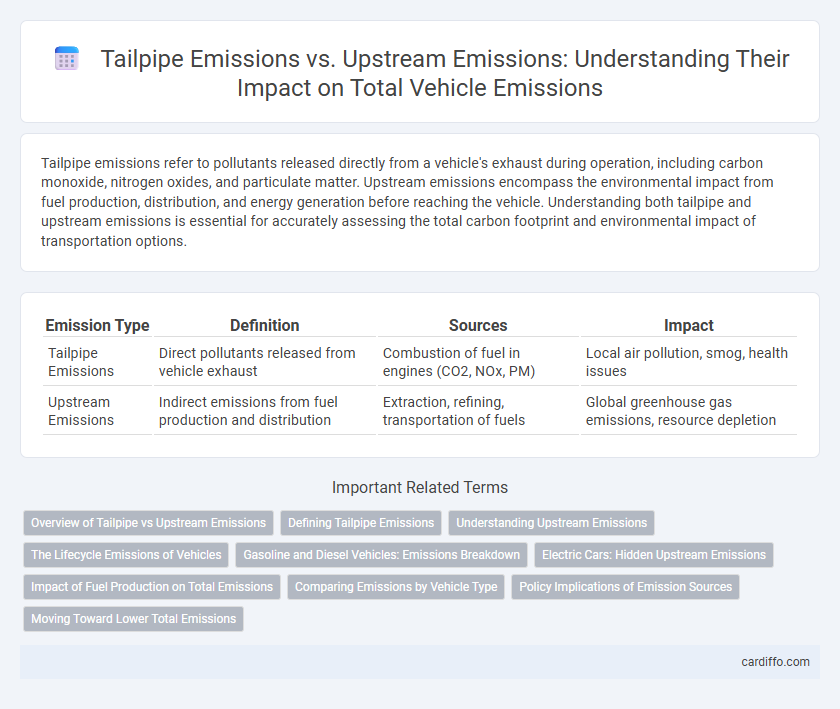Tailpipe emissions refer to pollutants released directly from a vehicle's exhaust during operation, including carbon monoxide, nitrogen oxides, and particulate matter. Upstream emissions encompass the environmental impact from fuel production, distribution, and energy generation before reaching the vehicle. Understanding both tailpipe and upstream emissions is essential for accurately assessing the total carbon footprint and environmental impact of transportation options.
Table of Comparison
| Emission Type | Definition | Sources | Impact |
|---|---|---|---|
| Tailpipe Emissions | Direct pollutants released from vehicle exhaust | Combustion of fuel in engines (CO2, NOx, PM) | Local air pollution, smog, health issues |
| Upstream Emissions | Indirect emissions from fuel production and distribution | Extraction, refining, transportation of fuels | Global greenhouse gas emissions, resource depletion |
Overview of Tailpipe vs Upstream Emissions
Tailpipe emissions refer to pollutants directly released from a vehicle's exhaust system during fuel combustion, including carbon monoxide, nitrogen oxides, and particulate matter. Upstream emissions encompass the indirect greenhouse gases and pollutants generated during fuel extraction, refining, and distribution processes prior to vehicle use. Comparing tailpipe versus upstream emissions is essential for accurately assessing the total environmental impact of different fuels and transportation technologies.
Defining Tailpipe Emissions
Tailpipe emissions refer to the pollutants released directly from a vehicle's exhaust system during combustion, including carbon monoxide, nitrogen oxides, hydrocarbons, and particulate matter. These emissions are a primary focus of regulatory standards due to their immediate impact on air quality and human health. Unlike upstream emissions, which encompass the full lifecycle emissions from fuel production and distribution, tailpipe emissions are localized and measurable at the source.
Understanding Upstream Emissions
Upstream emissions refer to the greenhouse gases and pollutants released during the extraction, production, and transportation of fuels before they reach the vehicle's tailpipe. These emissions include methane leaks from natural gas production, carbon dioxide from refining processes, and particulate matter from fuel transport. Understanding upstream emissions is crucial for accurately assessing the total environmental impact of different fuel types and improving lifecycle emission accounting.
The Lifecycle Emissions of Vehicles
Tailpipe emissions refer to the pollutants released directly from a vehicle's exhaust during operation, including carbon dioxide (CO2), nitrogen oxides (NOx), and particulate matter (PM). Upstream emissions encompass the greenhouse gases and pollutants generated throughout the fuel production and distribution process, such as extraction, refining, and transportation of gasoline or diesel. Evaluating the lifecycle emissions of vehicles requires combining tailpipe outputs with upstream impacts to accurately assess total environmental footprints and drive effective policy decisions in reducing overall carbon emissions from transportation.
Gasoline and Diesel Vehicles: Emissions Breakdown
Tailpipe emissions from gasoline vehicles primarily consist of carbon monoxide (CO), nitrogen oxides (NOx), hydrocarbons (HC), and particulate matter (PM), whereas diesel vehicles emit higher levels of NOx and PM but lower CO and HC. Upstream emissions include the environmental impact from fuel extraction, refining, and distribution, with diesel fuel generally producing higher upstream greenhouse gas emissions due to more energy-intensive refining processes. When comparing the total emissions footprint, diesel vehicles often have lower tailpipe CO2 but significantly greater upstream emissions, making the overall environmental impact dependent on the entire fuel lifecycle.
Electric Cars: Hidden Upstream Emissions
Electric cars produce zero tailpipe emissions, significantly reducing local air pollution. However, upstream emissions from electricity generation and battery production contribute substantially to their overall environmental footprint. The carbon intensity of the energy grid directly impacts these hidden upstream emissions, influencing the true sustainability of electric vehicles.
Impact of Fuel Production on Total Emissions
Tailpipe emissions represent the direct pollutants released by vehicles during combustion, while upstream emissions encompass the entire fuel production lifecycle, including extraction, refining, and transportation processes. The impact of fuel production on total emissions can be significant, often accounting for a sizable portion of greenhouse gas outputs, especially in fuels like gasoline and diesel. Evaluating both tailpipe and upstream emissions provides a comprehensive understanding of a vehicle's true environmental footprint and highlights opportunities for emission reductions across the supply chain.
Comparing Emissions by Vehicle Type
Tailpipe emissions primarily arise from internal combustion engine vehicles, releasing significant amounts of CO2, NOx, and particulate matter during fuel combustion. Upstream emissions, including extraction, refining, and distribution of fuels, contribute notably to the overall carbon footprint of both conventional gasoline and diesel vehicles. Electric vehicles exhibit near-zero tailpipe emissions but experience upstream emissions mostly associated with electricity generation, which vary significantly based on the energy mix used for charging.
Policy Implications of Emission Sources
Tailpipe emissions directly impact urban air quality and are the primary focus of vehicle emission regulations such as Euro 6 and EPA standards. Upstream emissions, including those from fuel extraction, refining, and delivery, contribute significantly to overall greenhouse gas footprints and require integrated policy approaches encompassing energy production and transportation sectors. Effective climate policies must address both tailpipe and upstream emissions to ensure comprehensive emission reductions and meet international targets like the Paris Agreement.
Moving Toward Lower Total Emissions
Tailpipe emissions represent pollutants directly released from a vehicle's exhaust during operation, while upstream emissions encompass the environmental impact from fuel extraction, processing, and distribution. Achieving lower total emissions requires addressing both tailpipe and upstream sources through cleaner fuel technologies, improved energy efficiency, and electrification. Transitioning to renewable energy inputs in fuel production significantly reduces upstream emissions, complementing advancements in vehicle emission controls.
Tailpipe Emissions vs Upstream Emissions Infographic

 cardiffo.com
cardiffo.com